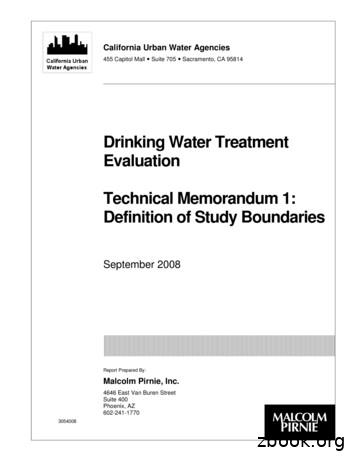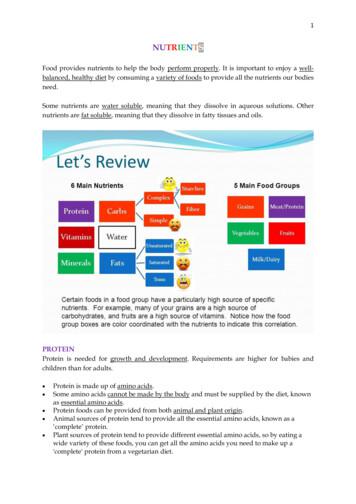Nutrients In Drinking Water - WHO
Nutrients in Drinking WaterWater, Sanitation and HealthProtection and the Human EnvironmentWorld Health OrganizationGeneva
WHO Library Cataloguing-in-Publication DataNutrients in drinking water.1. Water supply. 2. Potable water. 3. Water treatment. 4. Nutrition. 5. Micronutrients. I. WorldHealth Organization.ISBN 92 4 159398 9(NLM classification: WA 687) World Health Organization 2005All rights reserved. Publications of the World Health Organization can be obtained from WHO Press, WorldHealth Organization, 20 Avenue Appia, 1211 Geneva 27, Switzerland (tel: 41 22 791 3264; fax: 41 22 7914857; email: bookorders@who.int). Requests for permission to reproduce or translate WHO publications –whether for sale or for noncommercial distribution – should be addressed to WHO Press, at the aboveaddress (fax: 41 22 791 4806; email: permissions@who.int).The designations employed and the presentation of the material in this publication do not imply theexpression of any opinion whatsoever on the part of the World Health Organization concerning the legalstatus of any country, territory, city or area or of its authorities, or concerning the delimitation of its frontiers orboundaries. Dotted lines on maps represent approximate border lines for which there may not yet be fullagreement.The mention of specific companies or of certain manufacturers’ products does not imply that they areendorsed or recommended by the World Health Organization in preference to others of a similar nature thatare not mentioned. Errors and omissions excepted, the names of proprietary products are distinguished byinitial capital letters.All reasonable precautions have been taken by WHO to verify the information contained in this publication.However, the published material is being distributed without warranty of any kind, either express or implied.The responsibility for the interpretation and use of the material lies with the reader. In no event shall theWorld Health Organization be liable for damages arising from its use.The named authors alone are responsible for the views expressed in this publication.Printed at the Printing and Binding Service WHO Geneva, Switzerland
TABLE OF CONTENTSPreface .iAcknowledgements .iii1. NUTRIENTS IN DRINKING WATER - Consensus at Meeting . 1I.Introduction.1II.Topics Examined in the Meeting.3III.Drinking Water and Health Relationships.6IV.Conclusions and Recommendations .102. DESALINATION GUIDELINES DEVELOPMENT FOR DRINKING WATERBACKGROUND (Joseph A. Cotruvo). 13I.Introduction.13II.Drinking Water Production .13III.Desalination Technologies .16IV.Membranes.17V.Distillation Technologies .17VI.Other Systems .18VII.Potential Technical Issues Associated With Desalination.19VIII.Petroleum Contamination.20IX.Conclusion .233. WATER REQUIREMENTS, IMPINGING FACTORS AND RECOMMENDEDINTAKES (Ann C. Grandjean). 25I.Introduction.25II.Adverse Consequences of Inadequate Water Intake, Requirements for Water, andFactors that Affect Requirements.254. ESSENTIAL NUTRIENTS IN DRINKING WATER(Manuel Olivares & Ricardo Uauy) . 41I.Introduction.41II.Definition of Nutritional Requirements and Recommendations.41III.What are the Important Dietary Minerals and Electrolytes in the Diet and Potentiallyin Water that are Essential for Nutrition and Wellbeing?.43IV.What are the RDAs for Minerals and Electrolytes and how are they determined? .44
5. MINERALS FROM DRINKING WATER: BIOAVAILABILITY FOR VARIOUSWORLD POPULATIONS AND HEALTH IMPLICATIONS (Choon Nam Ong) . 61I.Introduction.61II.Studies in Asia .61III.Studies in Pan-America .63IV.Studies in Africa .64V.Studies in North America.64VI.Studies in Europe .65VII.Studies in the Western Pacific Region.68VIII.Conclusion .686. THE CONTRIBUTION OF DRINKING WATER TO TOTAL DAILY DIETARYINTAKES OF SELECTED TRACE MINERAL NUTRIENTS IN THEUNITED STATES (Joyce Morrissey Donohue, Charles O. Abernathy,Peter Lassovszky, George Hallberg) . 75I.Introduction.75II.Sources of Information .76III.Data and Analysis.77IV.Results.80V.Conclusions .887. MINERAL ELEMENTS TO CARDIOVASCULAR HEALTH(Leslie M. Klevay & Gerald F. Combs) . 92I.Introduction.92II.Nutritional Determinants of Heart Disease Risk.92III.Water and Heart Disease .93IV.Other Illnesses Related to Water Mineral Content .93V.Hardness Good or Softness Bad?.93VI.Trace Elements in Water Supplies.94VII.Conclusion .958. STUDIES OF MINERAL AND CARDIAC HEALTH IN SELECTEDPOPULATIONS (Floyd J. Frost) . 101I.Introduction.101II.Magnesium Deficiency.101
III.Calcium, Copper, and Zinc Deficiencies .103IV.Magnesium, Strenuous Exercise, and Sudden Cardiac Death .103V.Conclusions .1039. HOW TO INTERPRET EPIDEMIOLOGICAL ASSOCIATIONS(Gunther F. Craun & Rebecca L. Calderon) . 108I.Introduction.108II.Types of Epidemiological Studies .109III.The Exposure-Disease Association .111IV.Causality of an Association.113V.Web of Causation .114VI.Conclusions .11410. WATER HARDNESS AND CARDIOVASCULAR DISEASE: A REVIEW OF THEEPIDEMIOLOGICAL STUDIES, 1957-78(Rebecca L. Calderon & Gunther F. Craun)) . 116I.Introduction.116II.Scientific Reviews by Expert Groups.116III.Summary of the Epidemiological Studies.118IV.Strength of Association .121V.Exposure-Response Relationship .122VI.Specificity of the Association .122VII.Reversibility .122VIII.Biological Plausibility .123IX.Conclusions .12311. DRINKING WATER HARDNESS AND CARDIOVASCULAR DISEASES:A REVIEW OF THE EPIDEMIOLOGICAL STUDIES, 1979-2004(Silvano Monarca, Francesco Donato, Maria Zerbini) . 127I.Introduction.127II.Methods .128III.Results.128IV.Discussion.130V.Conclusions .133
12. HEALTH RISKS FROM DRINKING DEMINERALISED WATER(Frantisek Kozisek) . 148I.Introduction.148II.Health Risks from Consumption of Demineralised or Low-mineral Water .150III.Desirable Mineral Content of Demineralised Drinking Water .155IV.Guidelines and directives for calcium, magnesium, and hardness levels in drinkingwater .157V.Conclusions .15813. NUTRIENT MINERALS IN DRINKING WATER: IMPLICATIONS FOR THENUTRITION OF INFANTS AND YOUNG CHILDREN (Erika Sievers)164I.Introduction.164II.Assessment of Mineral Intake in infant Nutrition.164III.The Quantitative Intake of Drinking Water in Infancy and early Childhood .165IV.The Contribution of Drinking Water to Nutrient Mineral Intake in Infancy and EarlyChildhood .169V.Conclusions .17514. FLUORIDE (Michael Lennon, Helen Whelton, Dennis O'Mullane,Jan Ekstrand) . 180I.Introduction.180II.Fluoride Intake in Humans.180III.Dental Effects of Ingested Fluoride .181IV.Ingested Fluoride and Health .182V.Implications of Desalination.182VI.Conclusion .183
PREFACEThe World Health Organization assembled a diverse group of nutrition, medical andscientific experts in Rome in November 2003, at the WHO European Centre for Environment andHealth, to address a number of questions relating to the nutrient composition of drinking waterand the possibility that drinking water could in some circumstances contribute to total dietarynutrition. The original impetus of the meeting was as a contribution to development of Guidanceon health and environmental aspects of desalination that was initiated by the WHO EasternMediterranean Regional Office, and intended ultimately to contribute to the development of the4th edition of the WHO Guidelines for Drinking Water Quality (GDWQ). There were 18 invitedexperts from Canada, Chile, Czech Republic, Germany, Ireland, Italy, Moldova, Singapore,Sweden, United Kingdom and United States of America. Additional papers were provided byinvitees who could not attend. The task was to examine the potential health consequences of longterm consumption of water that had been ‘manufactured’ or ‘modified’ to add or delete minerals.In particular, the meeting originated from the question of the consequences of the long-termconsumption of waters that had been produced from demineralization processes like desalinationof seawater and brackish water as well as possibly some membrane treated fresh waters, and theiroptimal reconstitution from the health perspective.The scope of the review included these questions: What is the potential contribution of drinking water to human nutrition? What is the typical daily consumption of drinking water for individuals, consideringclimate, exercise, age and other factors? Which substances are found in drinking water that can contribute significantly to health andwell-being? Under what conditions can drinking water become a significant contribution to the totaldietary intake of certain beneficial substances? What conclusions can be drawn about the relationship between calcium, magnesium andother trace elements in water and mortality from certain types of cardiovascular disease? For which substances, if any, can a case be made from the public health perspective forsupplementation of the mineral content of treated drinking water derived from demineralizedwater? What is the role of fluoride in such water with respect to dental benefits, dental fluorosisand skeletal fluorosis?Drinking water is usually subjected to one or more treatment processes aimed at improvingits safety and/or its aesthetic quality. Fresh waters can be treated by one or more processes such ascoagulation, sedimentation, granular media filtration, adsorption, ion exchange, membranefiltration, slow sand filtration, and disinfection, and sometimes softening. The conversion of highsalinity waters like seawater and brackish waters to potable water by desalination is beingincreasingly practiced in water-short areas as demand for water increases, and the technologybecomes more economically attractive. More than 6 billion gallons of desalinated water areproduced daily throughout the world. Remineralization of desalinated water is necessary tocontrol its aggressiveness to piped distribution systems. Since remineralization of desalinatedwater is required, a logical question is: are there methodologies that could bring with themadditional benefits such as by reconstituting certain important minerals?Natural waters are of widely diverse compositions depending upon their geologic andgeographical origin and the treatments that they have undergone. For example, rain waters andsome rain water-dominated surface waters have very low salinity and mineralization, whereassome ground waters can become highly, and sometimes excessively mineralized. Ifi
remineralization of processed water is desirable for health reasons, another logical question iswhether some na
WHO Library Cataloguing-in-Publication Data Nutrients in drinking water. 1. Water supply. 2. Potable water. 3. Water treatment. 4. Nutrition. 5.
Lesson 2: Nutrients We Need 29 2. Nutrients We Need. OBJECTIVES . To emphasize the similarities between humans and plants in the need for nutrients To learn about the six classes of nutrients and why we need all six of them To learn how to identify good food sources of selected nutrients To learn how plants provide us with nutrients
1.1 Drinking Water Quality 1.2 Community and Household Water Treatment 1.3 Need for Drinking Water Quality Testing 1.4 Drinking Water Quality Guidelines and Standards 1.5 Drinking Water Quality Testing Options 1.6 Lessons Learned 1.7 Summary of Key Points 1.8 References Section 2 Planning f
Best Practices Manual Office of Drinking Water Small Drinking Water Systems 1.0 Introduction New regulations pursuant to The Drinking Water Safety Act, administered by the Office of Drinking Water, resulted in changes to the approval, licensing, monitoring, record-keeping
1.1. Central Valley Drinking Water Policy Development The Drinking Water Policy will be considered as a Basin Plan amendment in 2009 or 2010. To provide the technical information needed for the development of the Drinking Water Policy, a Central Valley Drinking Water Policy Workgroup (Work Group),
ProcessLab water analysis systems from Metrohm are used to monitor the drinking water quality. Cape Town drinking water The drinking water of the City of Cape Town largely originates from unpolluted mountain catchments and is treated according to national and international drinking water standards in the city's water treatment facilities.
1. Past-Year and Past-Month Drinking and Driving Behavior 7 2. National Estimates of Total Drinking and Driving Trips 9 3. Frequency and Amount of Drinking for Drinker-Drivers vs. Others Who Drink 11 4. Most Recent Driving After Drinking Occasion 13 5. Calculated or Estimate BAG for Most Recent Drinking-Driving Occasion 15 6.
Binge (Episodic) Drinking: Having 5 or more drinks on a single occasion at least once in the past 30 days. Moderate Drinking: 1 drink per typical drinking occasion at least once a week, or 2-4 drinks per typical drinking occasion 2-3 times per month, or 5 or more drinks per typical drinking occasion once a month or less, or
NUTRIENTS Food provides nutrients to help the body perform properly. It is important to enjoy a well-balanced, healthy diet by consuming a variety of foods to provide all the nutrients our bodies need. Some nutrients are water soluble, meaning that they dissolve in aqueous solutions. Other























